Baptiste was born in 1992 and has been into motorsports since he was four years old. He started with karting then eventually made it onto two wheels with motocross! Not long after he got a camera for Christmas he started shooting his motorsports adventures with his friends. At first he was shooting almost everything as a hobby but soon enough he discovered that petrol was flowing in his veins. He decided that he wanted to make his dreams come true and dedicate his life to photography! He joined the King of Europe Drifting Championship (now known as DriftKings International) media crew and started to expand his knowledge and style. His primary goal was to tell stories to the viewers and make them want to come to drifting events!
Words and images by Baptiste Billardello

Drifting - some say it’s a verb, but car guys would say it’s a smoking activity! Without a doubt, with 24 worldwide events and its multinational driver lineup, DriftKings International is one of the largest drifting championships.

Sit back and buckle up as I bring you with me, and the media crew, to the experience that was last year's race.
Welcome to Serres, Greece, a small town far from all the tourist sites of Greece and roughly a one-hour drive from Thessaloniki, which is the biggest town in the area. As soon as you arrive in the suburbs of Serres you can immediately tell that it’s not a huge city. But this small town has the one thing that every car enthusiast craves - a racetrack.
As a motorsports photographer, location is key, as it can affect photos dramatically, from making a shot look casual, with no interest, to completely epic! Serres Raceway is one of those places where everything is in synergy and highly skilled drivers from around the world are surrounded by perfect scenery. Unlike most tracks, this is one that offers an unlimited amount of locations to shoot from. This is what we call an open door, as it allows us to be extremely creative with our shots through numerous different styles and angles. In one word, Heaven!
I joined the actual media team around the middle of the 2018 season. The crew was composed of an official videographer and a photographer. Both of whom are ultra creative petrolheads who have been following the championship for five years now. They have been 100% dedicated to providing the best content to the viewers in order to provide a lifelike experience to those who are unfortunate enough to not be able to attend.

The biggest challenge we, as motorsports photographers and videographers, have is being exposed to many hostile environments, as well as difficult conditions during an event. Many times we must walk long distances and sometimes crawl around to find those amazing vantage points. Running to grab those unexpected sick shots is not out of the question and we must always be prepared to move.
Just imagine yourself carrying all your gear through the late Greek summer, with temperatures around 40°C. You are between the blistering sun and the tarmac, which is reflecting heat directly on you. There is usually no wind to provide relief except the wind created by the drift cars passing by in an instant, creating mass amounts of smoke and flinging rubber, rocks, dust, and debris as they careen towards you. They disappear as quickly as they arrive and you are grateful for the brief moment you had with them. All this is happening while you are watching the incoming threatening weather descend upon the track with the thought of, “this is going to turn into utter chaos"!
Even with the already tough conditions, I am always searching for a place to take unique shots, whether that place that is simply overlooked or just not known. Sometimes that means crawling on boiling hot tarmac or through overgrown vegetation. I will sacrifice my own comfort rather than miss an opportunity for what could be the best shot of the weekend. One of my crew members even took a bite from an insect which made his leg swell to twice the size over the course of the weekend. This did not deter him from continuing, after seeking treatment.

f-stop has done what many other camera bag companies have failed to do - make both my back and gear happy! The f-stop Tilopa pack that I chose compromises nothing between gear protection and personal comfort. Its ultra-customizable Internal Camera Units (ICUs) allow you to conveniently arrange your gear while retaining comfort with supportive, yet soft shoulder straps. The ICU system allows you to safely pack an extensive range of gear with the largest ICU or to maximize cargo space with a smaller ICU. The choice is yours, depending on the shooting location, since it is sometimes necessary to have space for food, water, and even medical supplies.
Even though this pack might seem huge at first glance, it is small enough to be claimed as a carry-on bag, believe it or not. It is the perfect pack for traveling photographers and videographers who do not want to sacrifice equipment safety.
The days of having the pre- and post-flight stress of wondering if your gear will arrive and will it be in one piece and wondering if you can risk running or crawling without damaging your gear are definitely over! For now, I’m the only f-stop gear user in the crew, but I am confident that it won’t take long for each of my colleagues to upgrade to f-stop gear!

Late Friday afternoon, before the race weekend, provided a breathtaking scenic backdrop that I was not quite expecting, which made for the best moment of the adventure. We had arrived early in the morning to scout out some key shooting locations that would provide the best angles, and while doing so, discovered that there would be some training at the end of the day. The smoke pouring off the tails of the drift cars and mingling with the colorful rays of the setting sun made for an epic golden hour!
I am a huge fan of the golden hour in street photography due to the ease of shooting during the perfect lighting. When it comes to motorsports, though, it creates a challenge as you must plan out your position perfectly. You can’t change the track layout, so you either have to rush into position or be there waiting for this precise moment. Planning accordingly is key as you may have to cross the track or walk a long distance to get that perfect backdrop.

When you nail that perfect spot though, and sit there like a sniper waiting for that perfect moment when the drift cars come into focus, your end result is a perfect synergy of drift cars and bellowing smoke turning from white to yellow to orange in the classic Serres golden-hour light. What a pleasure it is to work there!

One tip that I have always used, since I first started photography seven years ago, is to never upgrade your gear until you have mastered the gear you already own. I think that a lot of my colleagues would agree with me; however, I chose to purchase a Canon EOS-1D X Mark II with multiple lenses. This gear is nothing short of epic. This set up helps increase my “WOW” shot ratio and functions exceedingly well in difficult conditions. The event in Greece was a testament to that, with the hot temperatures combined with dust and smoke. A consumer camera would have struggled to obtain good shots.

What happens when you put camera-addicted petrolheads and drift cars in the same amazing location for a weekend? You end up with a solid team that will scour the track for the best angles of the event and provide this content to the unfortunate fans who were unable to attend the event. My specific role in the team is to take photos, simple and concise, but it’s way more than that to me. Each photo adds to the story of the event through my eyes and then through my camera lens, which portrays the feelings that I had at the exact moment the shutter opened and snapped shut.

Now that I am part of the DriftKings media crew, I will continue providing awe-inspiring content throughout the 2019 season. Not only that, but I will also be following a French rookie driver by the name of Mathieu Bareyt throughout this year’s DriftKings Championship and the French Drifting Championship. Last, but not least, I will be stepping up my game with classic car photography and reaching out to private clients, as well as companies, for commissioned work.

You can find most of my work on my website and on Instagram at @dgpmedia, at @driftkings_ig, and at @vikingsmachine_drift.
I will forever be grateful to Mike Procureur, DriftKings CEO, who made this adventure possible! And also to the DriftKings crew who did an awesome job last season!
"We Are f-stop" is for all f-stop users to share their stories from the field, from small daily adventures to epic travels. Contact us with your story on Facebook or drop us an email to [email protected] and let us know where your photography takes you and your f-stop pack!
SHOP ALL GEAR MORE WE ARE f-stop


©2022 F-stop
f-stop customer Sam Sapp is a photographer and Firefighter & EMT based in Southwest Virginia, USA. In this 'We Are f-stop' Sam got in touch with us to share his passion for photography, whether travelling in Italy or Scotland, or close to home in the Blue Ridge Mountains of the Appalachian range with his Guru UL. He also shares a great tip about using his ICU as a hand carry item when travelling with a fully packed bag...
Words and photos by Sam Sapp
I love taking pictures of life, anywhere from travel to candid family photos in the backyard. For me, photography is a form of storytelling that has the ability to show a person’s life not just in terms of still images, but also in terms of emotions. My all-time favorite photos are candid family shots. I love being able to preserve these very special moments and see the joy on the families faces when I freeze time while simultaneously providing memories that they can cherish for a lifetime.

I have been to Scotland, Poland, Italy, and Ireland to name a few and never travel without my Satori EXP camera bag. Packing light for international flights is key. The bag fits in the overhead compartment and I even has room for my clothes. When packed to the max I can always take out my ICU and put it under the seat. The removable ICU makes inspection stations at airports a breeze.
Whether it’s being up at dawn and hiking Isle of the Skye to capture the perfect sunset, navigating the winding canals of Venice, enjoying one of the many Piazzas, walking the city streets of Krakow and Dublin, or being 443ft underground in the Wieliczka Salt Mine, I always have the Guru UL bag. The Guru is also my everyday bag that I use during events and photo shoots. I grab this bag and I am off with little to no time to prepare I have everything I need in this lightweight bag including a jacket and a snack.

Photographs have become my visual journal, snapping pictures of the world freezes memories and creates art for others to enjoy and living in the Blue Ridge Mountains makes it easy to capture beauty right here at home.

See more of Sam's work on his Facebook Page .
"We Are f-stop" is for all f-stop users to share their stories from the field, from small daily adventures to epic travels. Contact us with your story on Facebook or drop us an email to [email protected] and let us know where your photography takes you and your f-stop pack!
SHOP ALL GEAR MORE WE ARE f-stop


©2022 F-stop
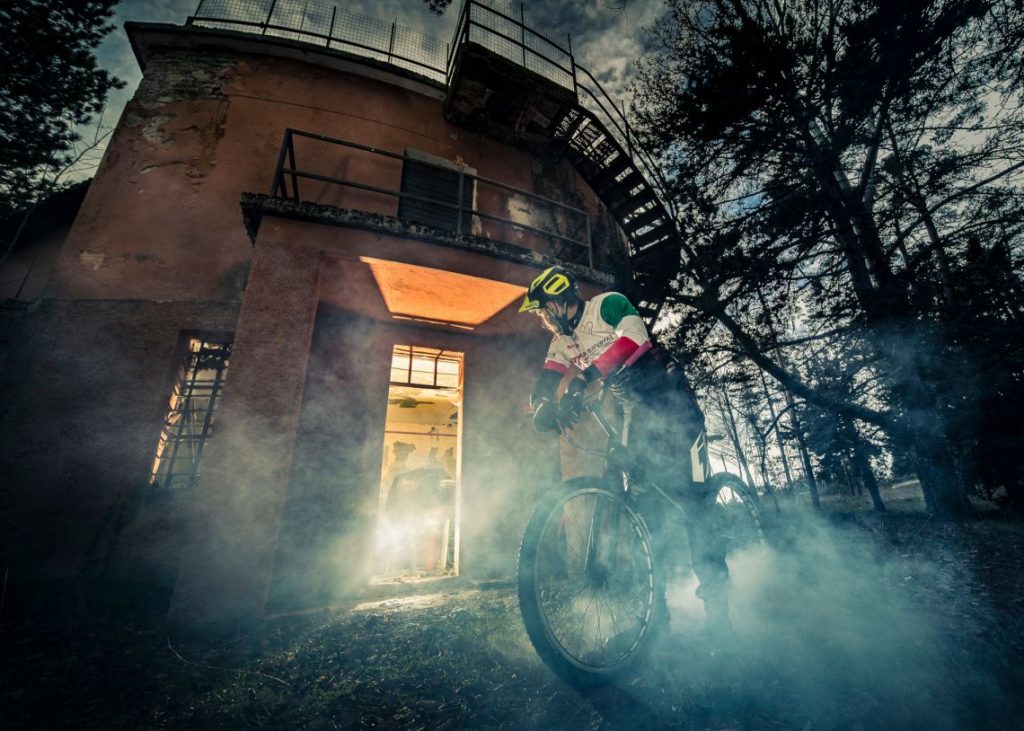
Ten years ago, my hometown of L’Aquila, Italy was struck by a dreadful earthquake. Until recently, I did not have the courage to take pictures of the destruction.
Now, through my camera, I have found the motivation to express the anger, sadness, and desire for rebirth that I have felt inside since that day. Using my camera, I can focus a high-level of attention on places that are symbols of abandonment in my beloved city.
Words and images by Luca Parisse

Renatas Salichovas, a professional trial biker, has been fundamental in achieving this project.
Renatas faced big urban obstacles while biking in L’Aquila. The obstacle would stop his path. He would have to study it, analyze it, and get through it.

Jumping over the obstacle, looking ahead to the future, but without forgetting the past. This is the motto of my project.
Renatas faced many difficulties in the devastated city. A professional athlete conditioned to face outdoor challenges, he had to adjust to the urban environment. Sometimes, the walls on which he jumped crumbled. It was never certain whether a wall would support him and his bike. Due to this, the technical acts he carried out were often un-repeatable, as it was too dangerous for Renatas to try more than once.

Weather also posed a challenge. L’Aquila is nestled amongst mountains and received much snowfall this past year. Over our long period of shooting (November 2018 to March 2019), it was necessary to take many breaks for bad weather.
Fighting against the cold and wind, Renatas worked to balance his bike on very high walls.
I needed to shoot him from a long distance, in a perfect position between two windows of a destroyed building… and we managed to do this!


It was often necessary to use artificial lights to brighten desolated places and underline the tragedy of the site. Many times, I would set up a power generator and a smoke machine to create a mystical atmosphere, like a forgotten forest.

Despite all these challenges, Renatas satisfied all my requests. It is very important that there is great harmony and confidence between athlete and photographer.

I am a sports photographer. But, for the first time, I managed through action photography to convey a social problem. In this case, the abandonment of places in my city. I hope to send a message to continue to fight for a better future in my city.
I will present my work in the major city of my region, and in autumn my photos will be in Rome and Milan.
Riding Death in Town, a jump toward the future!

During the shooting i used Loka UL mostly with this equipment:
Canon Eos 1d X mkII camera, Canon eos 6d mlii backup camera
Canon 24mm ts-e, 24-70mm 2,8 II, 70-200mmm, f2,8 II and 35mm f1,4, 16-35mm f2,8
Elinchrom transmitter pro
1 High Performance Reflector 48° 26 cm
1 radio
1 Lasportiva goretex jacket
In the Shinn i brought:
1 elinchrom ELB 500 with action head
1 old elinchrom ranger quadra with action head
1 manfrotto nano tripod
1 elinchrome tripod.
"We Are f-stop" is for all f-stop users to share their stories from the field, from small daily adventures to epic travels. Contact us with your story on Facebook or drop us an email to [email protected] and let us know where your photography takes you and your f-stop pack!
SHOP ALL GEAR MORE WE ARE f-stop


©2022 F-stop
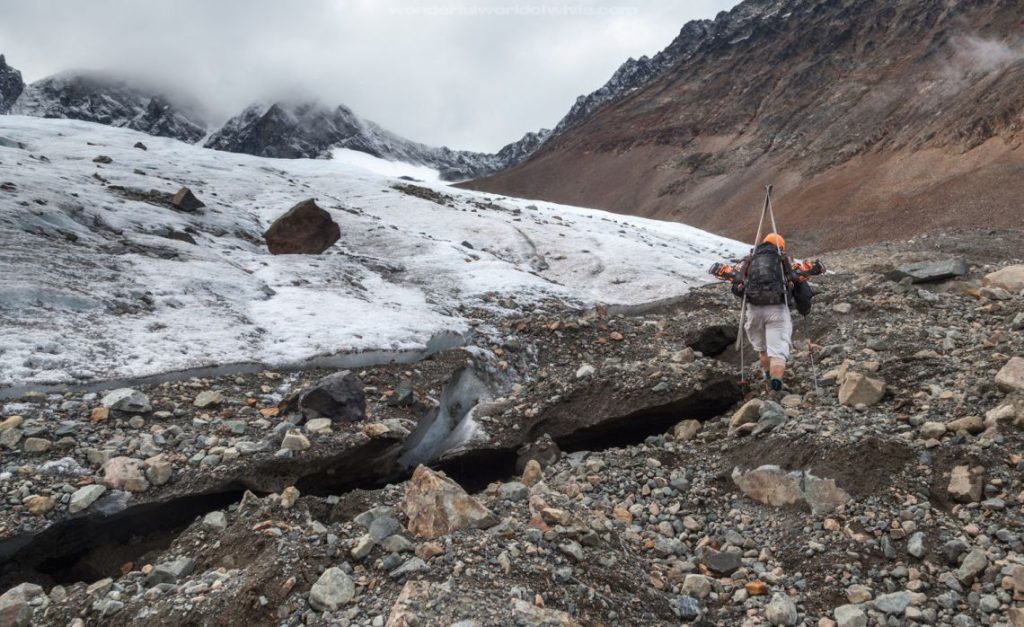
Our customer Curtis Cunningham is a freelance photographer living in Smithers, British Columbia, Canada. He enjoys using photography as a means to tell the story of the places he goes, and the adventures he has exploring the abundant natural beauty that surrounds him in BC. His first taste of backcountry skiing was in 2013, and began taking it seriously at the beginning of the 2014/15 season. Since then, every day that he has gone ski touring, his trusty f-stop Tilopa has gone with him, keeping his camera and other gear safe and dry. Curtis got in touch to share his personal take on ski touring and what drives him to keep heading out:
Words and photos by Curtis Cunningham

the people met and friendships made
the obstacles faced and challenges overcome
the beauty seen and wonder experienced
these are the hallmarks of my ski touring experiences thus far
and I’m just getting started

Wanting to do something different at the start of this season (which began for me on September 27, 2017) I began writing each evening after I come home from a day of skiing. I have several goals I hope to achieve with the stories that I tell: to share my experiences, what I feel, what my thoughts are, and the beauty that I see each day. I hope that the photos I make and the words I share give an raw, unvarnished window into the high and wild places of the world I call home.

I started ski touring regularly on November 1, 2014 and apart from two months in July and August of 2015, I've skied every month. So on this particular day, September 24, 2016, my streak was sitting at 12 consecutive months skiing and 20 out of the last 22 months. As September was quickly coming to a close, I needed to find some snow to keep my streak alive.
So I drove to the Twin Falls Recreation area (which is just outside of Smithers), and with my boots and skis A-framed on my Tilopa, I started hiking up the Glacier Gulch trail with the goal of skiing on the Kathlyn Glacier. It took close to 3 hours of hiking through the trees, up the scree and across the toe of the glacier to get to a point where I could make a few heinous turns.
I've come to firmly believe that skiing isn't so much about the quantity or even quality of snow I ski on. But rather, the most important thing is the experiences I have when I'm out on the snow. This day was certainly an early example of that maxim.

You can find more of Curtis' stories on www.wonderfulworldofwhite.com, and also make sure to check out his website, and Instagram channel.
"We Are f-stop" is for all f-stop users to share their stories from the field, from small daily adventures to epic travels. Contact us with your story on Facebook or drop us an email to [email protected] and let us know where your photography takes you and your f-stop pack!
SHOP ALL GEAR MORE WE ARE f-stop


©2022 F-stop
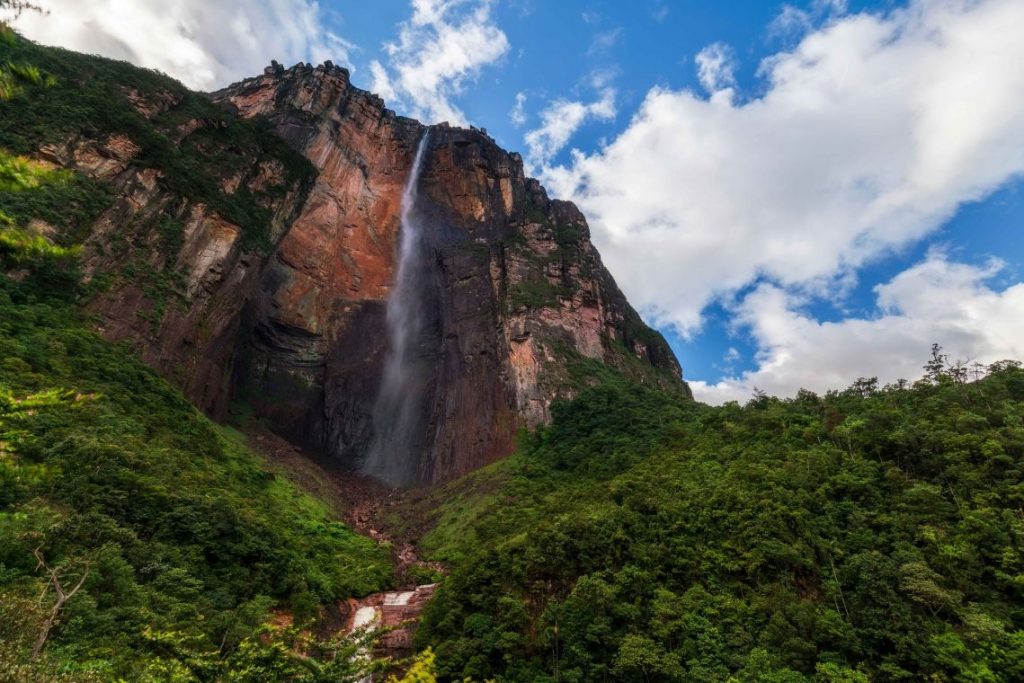
f-stop customer Mattia Bicchi got in touch with another adventure to whet your appetite to travel. Mattia is professional timelapse and hyperlapse photographer and filmmaker from Italy, now based in London. When he's not creating timelapse videos for clients, he's creating them on his own personal adventures. This time traveling through South America with his wife, capturing the stunning scenery along the way. Enjoy this instalment from Mattia making the journey to Angel Falls, and showing what amazing results can be achieved with a mirrorless set up and compact drone:
Words and photos by Mattia Bicchi

My wife and I are currently traveling through South America, making videos and TimeLapse. We recently went to Angel Falls in Venezuela, to get there we took a plane from Caracas to Puerto Ordaz where we stayed for a day to visit the beautiful ‘La Llovizna’ waterfall and where the Orinoco and Caroni rivers meet.
From Puerto Ordaz we got a small propeller plane to Canaima, a Pemon Village, where we were welcomed by our tour guide that took us to the Ucaima Camp, here we spent one night with an amazing view to the Carrao river and Tepuys.
The day after, at 6am with a small indigenous boat called Curiara we started sailing up to the Angel Falls, the journey was longer than usual, as the river was low and we had to get out the boat few times and push it against the current with the other guys. After 6 hours and a half we finally sighted the stunning falls from our boat, a scream of joy came from all of us, we never seen something so majestic!

We arrived at the base camp where we had lunch and got ready for the one hour walk through the jungle, with us we had a Black Loka and a Orange Lotus to carry our gear, the walk to the bottom of the falls was beautiful, we could feel hundreds of insects and birds singing around us, the tough part to walk through the jungle was the humidity, but once we arrived at the Mirador all the tiredness was gone, I took my tripod, my Sony A7rII and started shooting as much TimeLapse as I could, the feeling to be there and seeing with your own eyes this natural wonder so close, is indescribable. I also took out my Mavic Pro and went for a flight, what a flight!
As the river was low, we were able to go at the very bottom and dive into the small pool under the falls, there is nothing more energetic than swimming literally at the bottom of the Angel Falls!
We got back to the base camp just before sunset, where the locals made us an exquisite dinner, to finalise our day, we slept in an ‘Hamaca’ under the worming energy of the Auyan Tepuy.
The way back was a bit scary, as we started our journey during the night, we couldn’t see a thing, but the locals knew the river so well that they were able to avoid all the rocks that could flip over our boat. When the sun went up the journey was quite and relaxing, giving us the time to reflect on the incredible place we just witnessed.
This is Mattia's second We Are f-stop story - check out his trip to the Faroe Islands with another wonderful timelapse video here. You may find more of Mattia's work on his web site, Facebook and Instagram.
"We Are f-stop" is for all f-stop users to share their stories from the field, from small daily adventures to epic travels. Contact us with your story on Facebook or drop us an email to [email protected] and let us know where your photography takes you and your f-stop pack!
SHOP ALL GEAR MORE WE ARE f-stop


©2022 F-stop
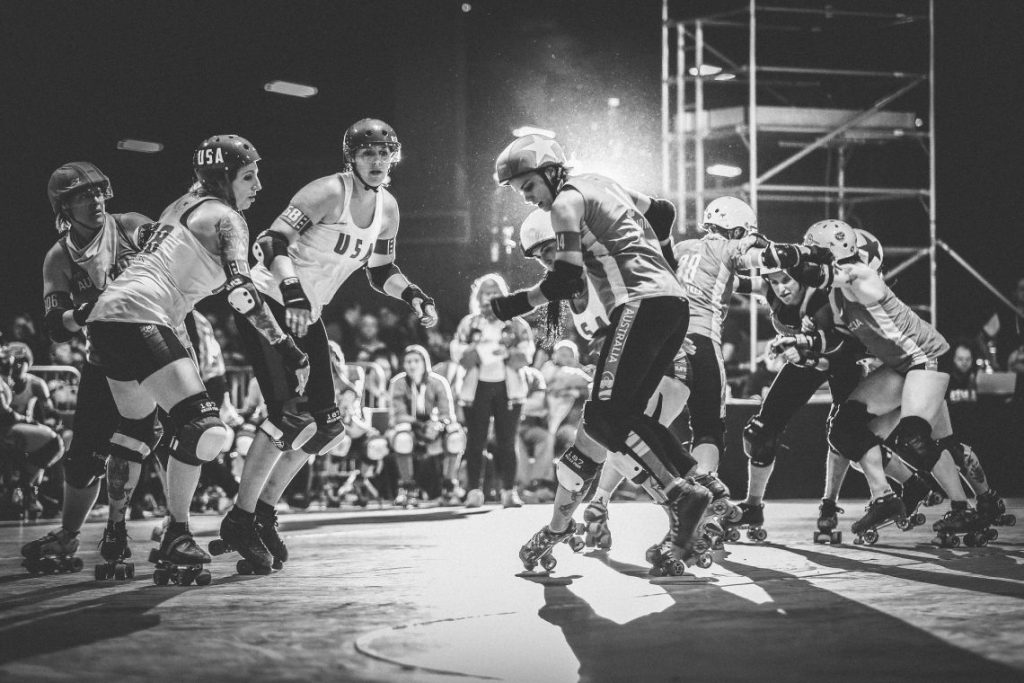
Our customer Stephanie Zakas is a photographer based out of Brooklyn, NYC, who specializes in romantic and adventurous weddings and also shoots travel related content. Alongside this work she has a passion for roller derby and is the official photographer for the USA Roller Derby national roller team, as well as Team Korea Roller Derby team. Roller derby is a quirky, inclusive, colorful and adrenaline-fuelled sport, which has its own World Cup in Manchester, England earlier this year. If you are not familiar with roller derby, let Stephanie give you a written and visual tour in her 'We Are f-stop' story:
Words and photos by Stephanie Zakas
Roller Derby is a full contact, high impact, fast paced sport that is 100% real and nothing like what everyone thinks of from back in the 1970’s. There is no ball, the points are scored by the player wearing the star on her helmet (called the Jammer), one on each team on the track at a time. Every other player is out there to stop her from scoring points by knocking her down and not letting her pass them. They are also trying to help their Jammer score points by getting her to pass the other players by knocking down the other players or moving them out of the way. It is offense and defense at the same time, unlike any other sport.

Women started and dominate the sport (WAHOO!) which is reflected in the name of the event. Unlike any other sport where the women’s team is the team to be gendered in the title (for example "Women's World Cup") in roller derby it is the men’s event that is called the ‘Men’s Roller Derby World Cup’ - while the women's is simpley "The Roller Derby World Cup".

The Roller Derby World Cup is held every four years. The location changes every tournament, and this year it was held in Manchester, in the U.K. This year there were 38 teams competing, including 'Team Indigenous' that represented Indigenous people’s from all over the globe.
The teams are comprised by nation-wide tryouts where the coaches and managers pick the best of the best players in the entire nation. The World Cup is a 5-day-long event, where teams start playing in brackets and start to knock each other out of the rankings. This all builds up to the the final game, which this year was USA vs Australia. When the dust settled USA Roller Derby took first place!


I have been playing roller derby for 12 years, and play for the New York City team which is how I got into roller derby photography. I shoot for my team's All Star team who is the charter team for national rankings. About two years ago, I was asked to be USA Roller Derby’s official photographer.


The photocrew was comprised of Team Shooters, Event Shooters, and Media Shooters. There were a total of 50 shooters credentialed. From a photographer perspective, the event is a high-stress situation - though insanely fun! It is very fast paced with 4 tracks all playing at the same time. You have to move your lights and set them up form track to track with hardly any leeway time. Between games if you have any time, we have to go back into our ‘photo village’ to dump cards, back up files, do a quick select and edit, then get photos out to news outlets, the teams, the companies who hire us independently to license our images to use. For example, I had skate companies, apparel companies, protective gear companies purchasing images off of me in real time. Then after shooting for 10+hrs, you go back to your hotel to finish up any post production and workflow, charge your gear batteries, sleep, then get up and do it again!

She grew up in Columbus, Ohio and then earned a degree in Film Production in Orlando, Florida where after graduation she saved money in a literal shoebox to buy her first camera 11yrs ago. After teaching herself how to shoot, Steph stayed in Orlando for a few years while shooting for Disney Creative Media at Walt Disney World before moving to New York City, where she has been ever since. She is passionate about travel and being able to create epic images out of the experiences she has. She believes that her clients should have just as much fun during the shoot as she does shooting. She is always up for a new adventure in any country, a new challenge, and a new way of documenting her surroundings.
See more of Stephanie's work on her web site, Instagram profile, and Facebook Page .
"We Are f-stop" is for all f-stop users to share their stories from the field, from small daily adventures to epic travels. Contact us with your story on Facebook or drop us an email to [email protected] and let us know where your photography takes you and your f-stop pack!
SHOP ALL GEAR MORE WE ARE f-stop


©2022 F-stop
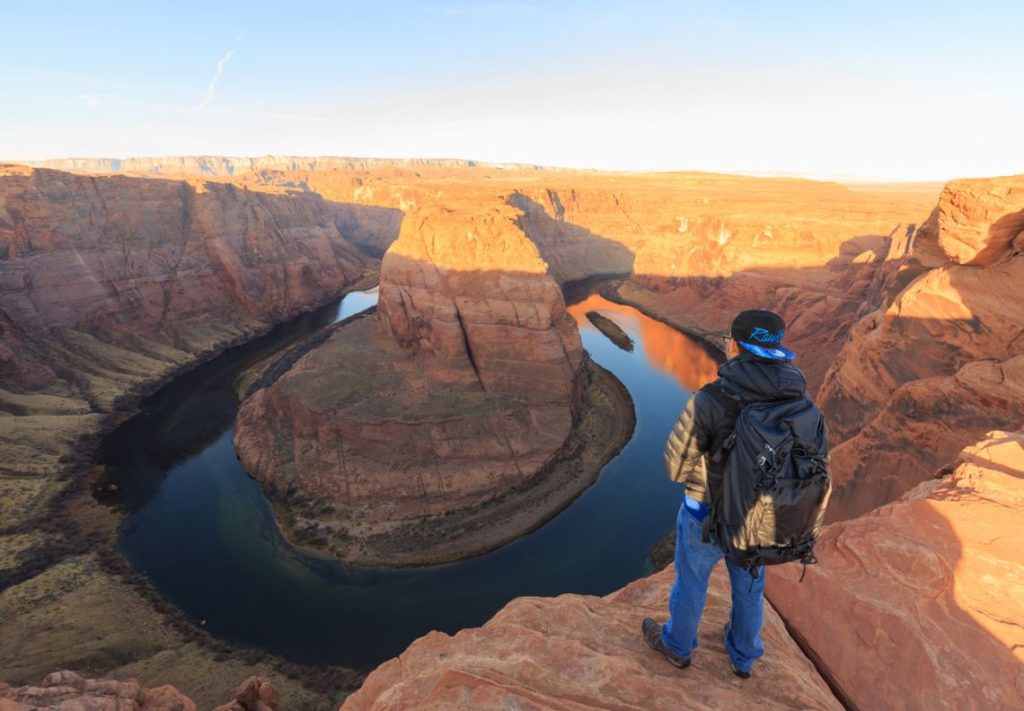
Customer Nelson Perez from South Florida got in touch to let us know how he uses his Ajna. Nelson graduated school as a graphic designer, then realized that he had a growing passion for photography. Working in the airline industry as a ground ops agent opened up the opportunity for discouted travel benefits. Since then, he's been bitten by the travel bug, always with his camera ready to capture each new journey, like this exploration of Arizona:
Words and photos by Nelson Perez
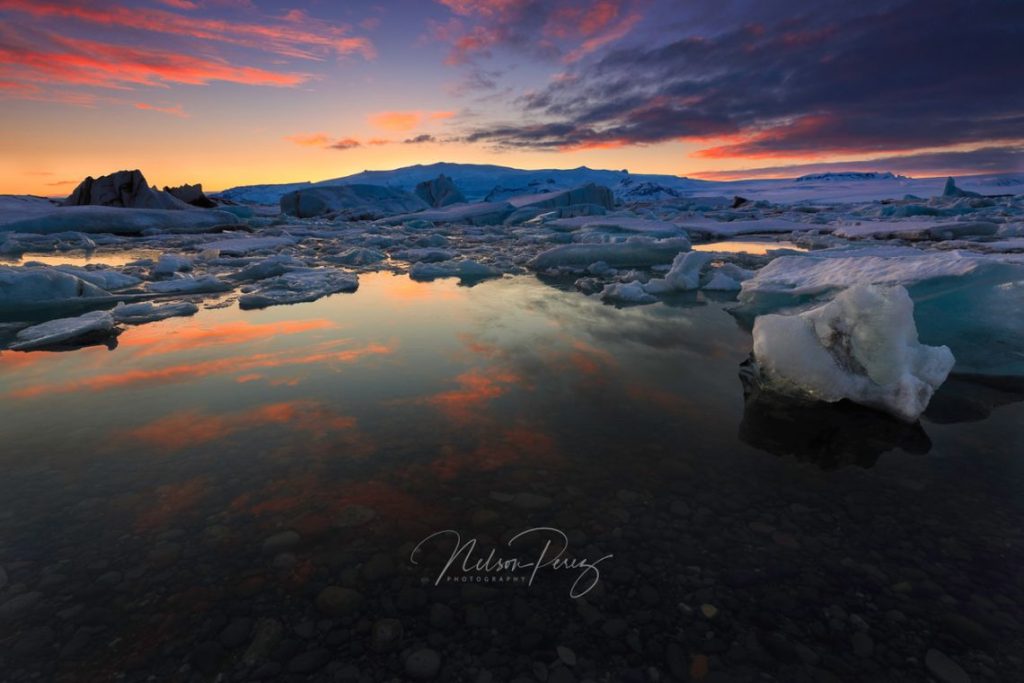
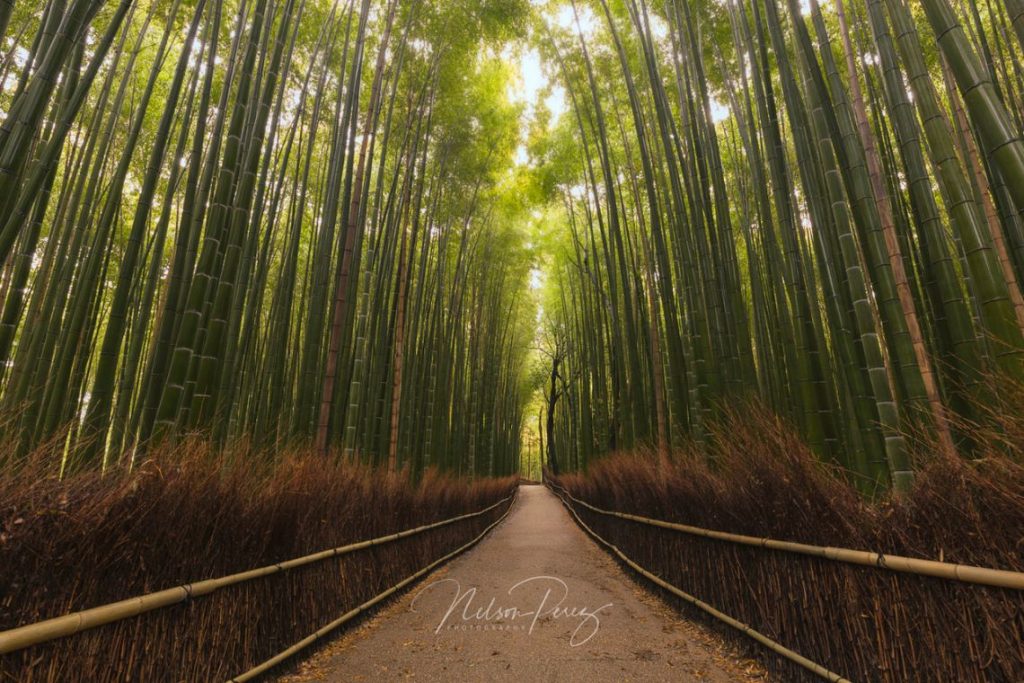
For the last three years, I have journeyed religiously with my wife, Erika, Capturing breathtaking photos nature has to offer. Like any other photographer, I’ve used a variety of camera bags in the past. Recently, I’ve searching for a bag that is both comfortable & spacious enough to hold all my equipment.
Last December my wife surprised with just that, The f-stop Ajna, Is a unique bag, Very different from my other ones. I didn’t know anything about the ICU compartment, Or about f-stop in general, Therefore I was very skeptical at first. After familiarizing myself with the bag, I realized that I can now travel comfortably & often with all my gear.



In January, my wife & I went to Arizona - I’m sorry - the beautiful state of Arizona. We explored Monument Valley, Antelope Canyon, Horseshoe Bend & Sedona. We survived the early mist & the cold, the dust & humidity of the canyons. I was blown away by the Ajna bag, All the gear it holds, The clever design & most importantly the protection & security.
I cannot be happier with my new bag & hope to continue exploring new & exciting places in the near future with this bag, Here are just a few of the many photos I’ve taken in Arizona.




You can find more of Nelson's work on his website, Facebook or Instagram channel.
"We Are f-stop" is for all f-stop users to share their stories from the field, from small daily adventures to epic travels. Contact us with your story on Facebook or drop us an email to [email protected] and let us know where your photography takes you and your f-stop pack!
SHOP ALL GEAR MORE WE ARE f-stop


©2022 F-stop
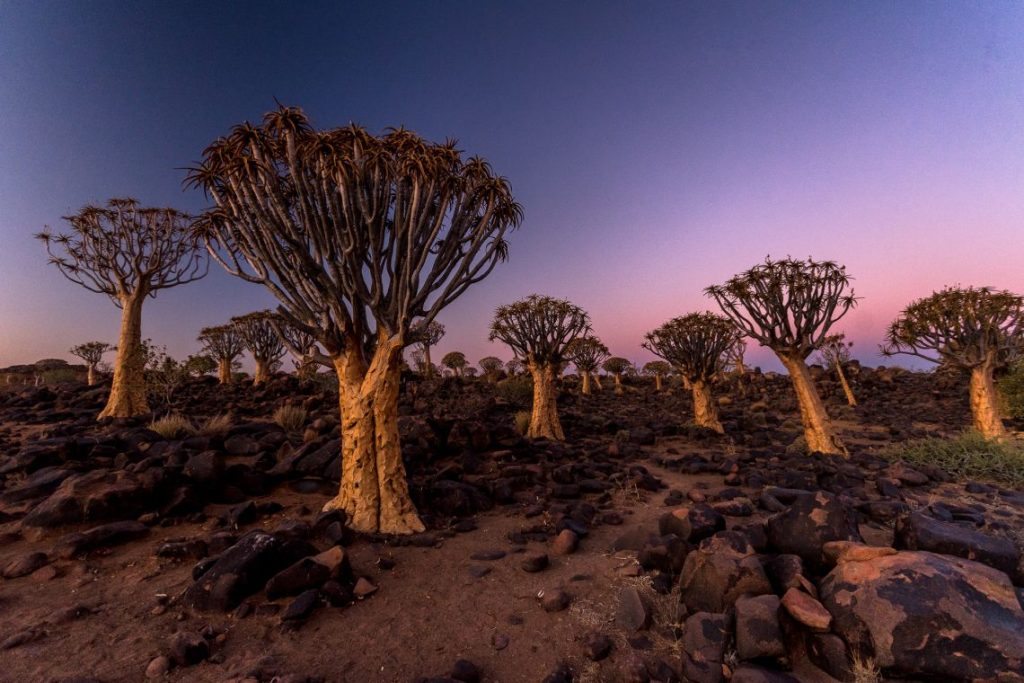
Juan Pablo Bassi is travel, outdoor and adventure photographer, he teaches landscape and documentary photography at a local photography school in Rosario, Argentina. Photography is a part-time job since 2012.
He tries to travel as much as he can inside his country. He's been published on the National Geographic Traveler Latin-American and in most the important climbing magazines of Argentina and Chile. He is always looking for new challenges, especially those involving mountains.
Words and images by Juan Pablo Bassi
As an Argentinian, traveling to other continents is always a big deal, long hours of flying, eternal layovers and jetlag.
From 02 to 19 of November, we got the chance to do a photographic trip to Namibia, we were excited about getting to meet for the first time a truly African desert and looking forward to seeing the big five.
What my wife Lucia and I didn’t know was that we were going to find a country that would highly surpass our expectations and what we had thought it would be a relaxing trip, ended up being one the most authentic adventures we have lived so far, with + 6500km of driving in 17 days through different deserts, mountains, and pans. Africa is one of the most spectacular continents to travel to, not only because of the wildlife but also because of its surprising cultures and landscapes.
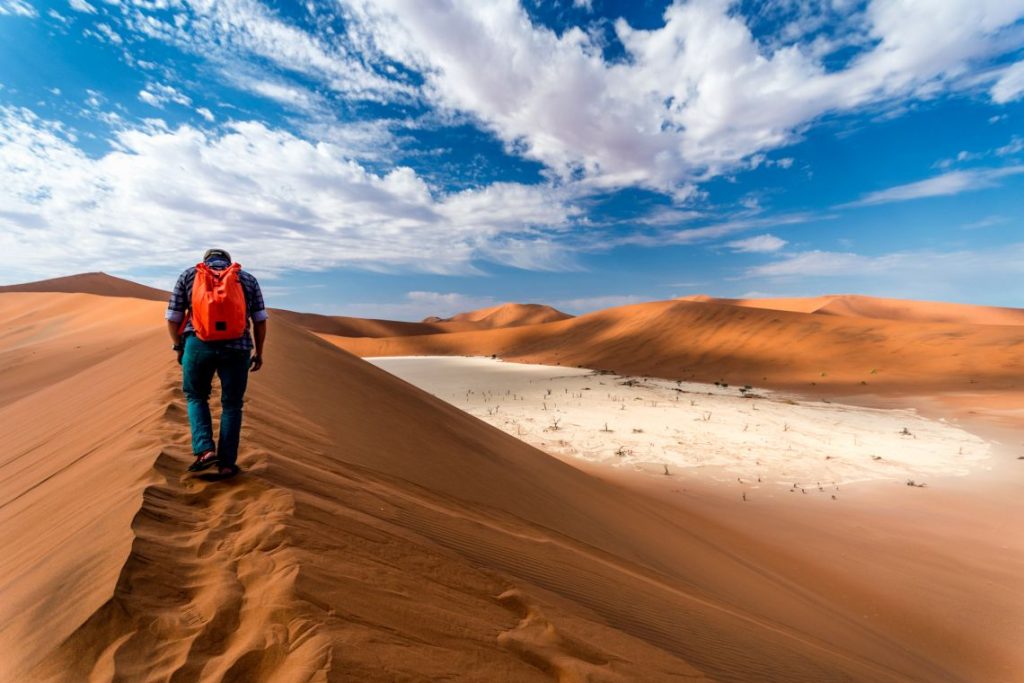
Every part of Namibia is worth to visit. Starting from the Fish River Canyon on the southern part, going through the ghost town of Kolmanskop into the Namib desert, and then enjoying the wildlife in Etosha and in the Kavango region on the north. Because of that, we decided to hire a 4x4 camper Ford Ranger that would take us wherever we wanted, providing us enough room to be comfortable and reliance to face bumpy roads, but Namibia is relentless and no matter the car, sometimes the road and the heat were our most fearless enemies.
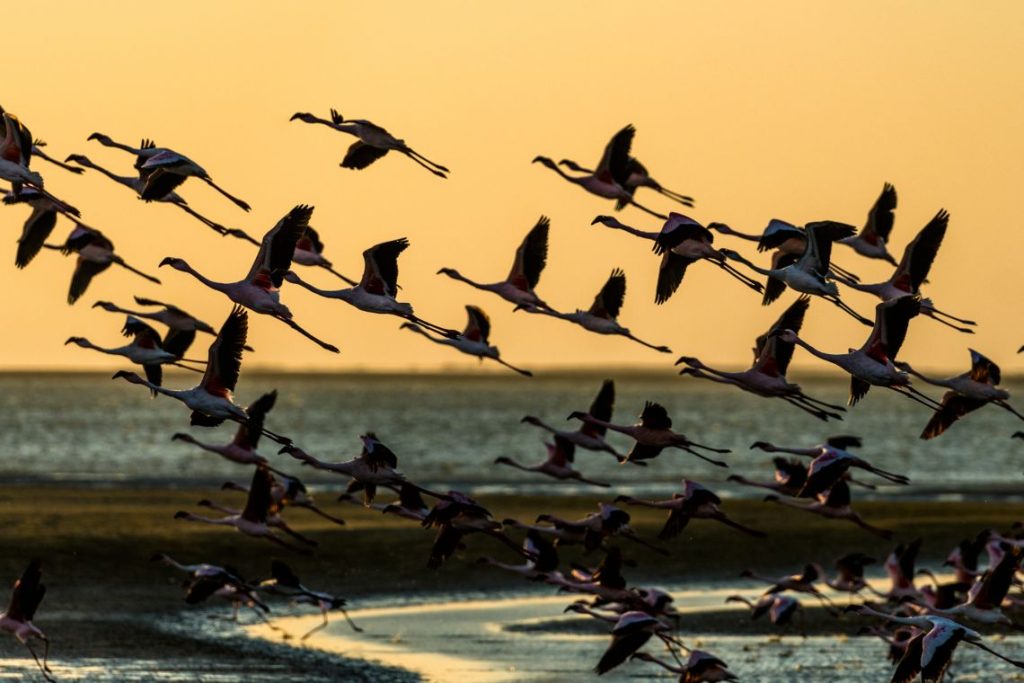
Each place I previously mentioned presents a photographic challenge, not only regarding technical aspects but also due to the weather and logistics. Getting to these places takes long hours and you will not always be at the right time to shoot. And not only that, it will be boiling and windy too. As every photographer should know the key is patience, and in Africa, you need a lot!
If we have to choose the best places we’ve been to in this trip, we will definitely choose the abandoned and astonishing city of Kolmanskop with houses full of sand, the incredibly never-ending sand dunes of the Namib Desert, and the amazing wildlife of Etosha National Park. For that photography quest, you will need to carry a variety of lenses, such as wide angles, normal and telephoto. In my case, I’ve carried a Nikon D500 with the Holy Trinity, 14-24mm f2.8, f24-70 2.8 and f70-200 2.8. along with an old analogic Nikon EL2 with a 50mm f2.0. Set of 3 Cokin ND filters, batteries, chargers and the rest.
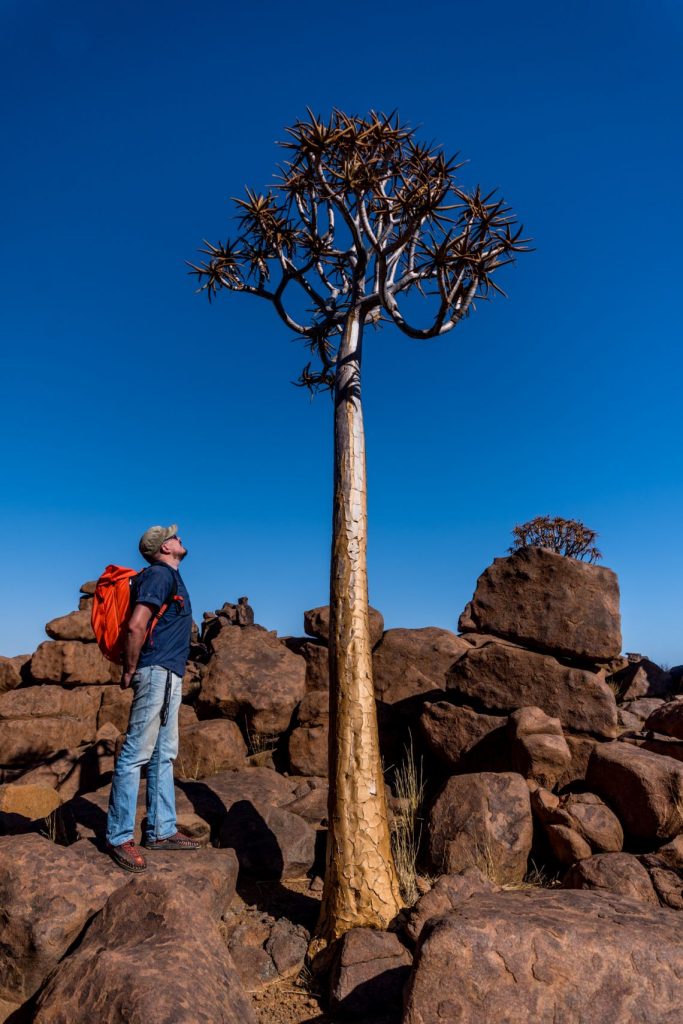
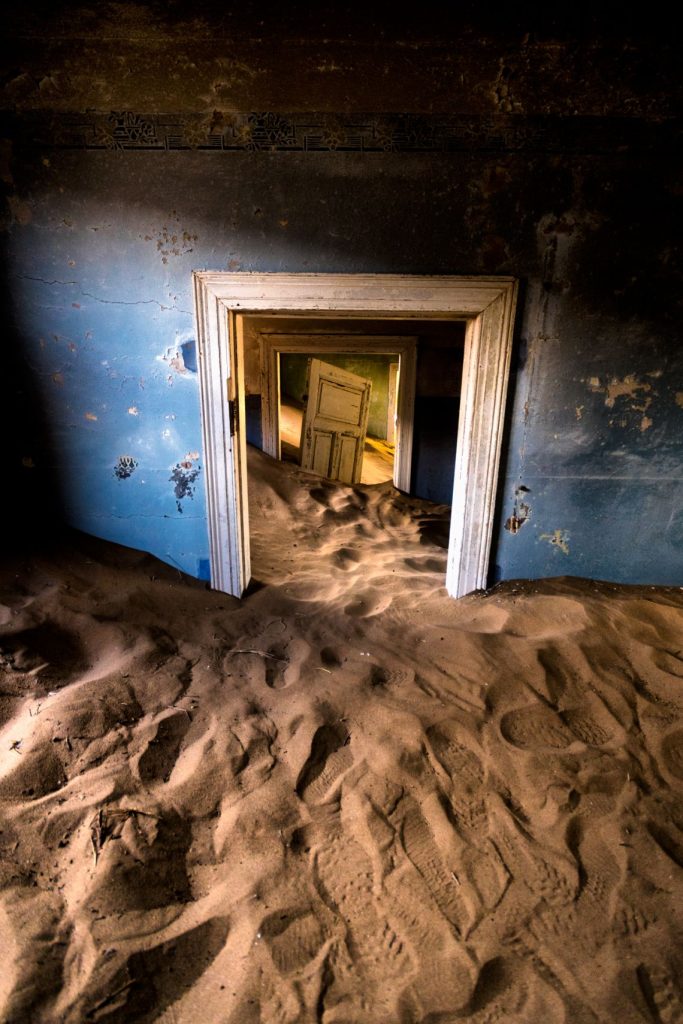
Regarding with the food, If you decided rather than the German go for the Namibian option, the typical food includes mahangu porridges, fish, beef stew, wild spinach (ombidi) and the exquisite mataranga (cow tripe), and if I have to recommend one, we will definitely go with the Oryx meat, absolutely fabulous. Eating like the locals will give you a better understanding of some aspects of their culture. As for the people, that’s a whole entire chapter, but just let me tell you that you will always feel welcome.

As an educator, I try not to always teach technical aspects of photography, but I usually try to talk about my experience to make the journey more pleasant. In this case, I would suggest you protect your gear from the sand. Namibia is a semi-arid country, so you will not have to worry about rain, as you will worry about sand storms. Don’t forget to take a long scarf, that will protect you from the sun, and will also give you the chance to wrap the equipment on those windy moments. Set up your camera and gear as far as possible from the sand, if it is inside your car better so that you can change lenses without any risk. For wildlife photography, carry a bag full of beans, not for eating them, but to place your telephoto lenses on it when you are inside the car. As for your photography equipment, always rely on your f-stop gear backpacks, because it´s not only a bag, it’s the perfect travel mate.
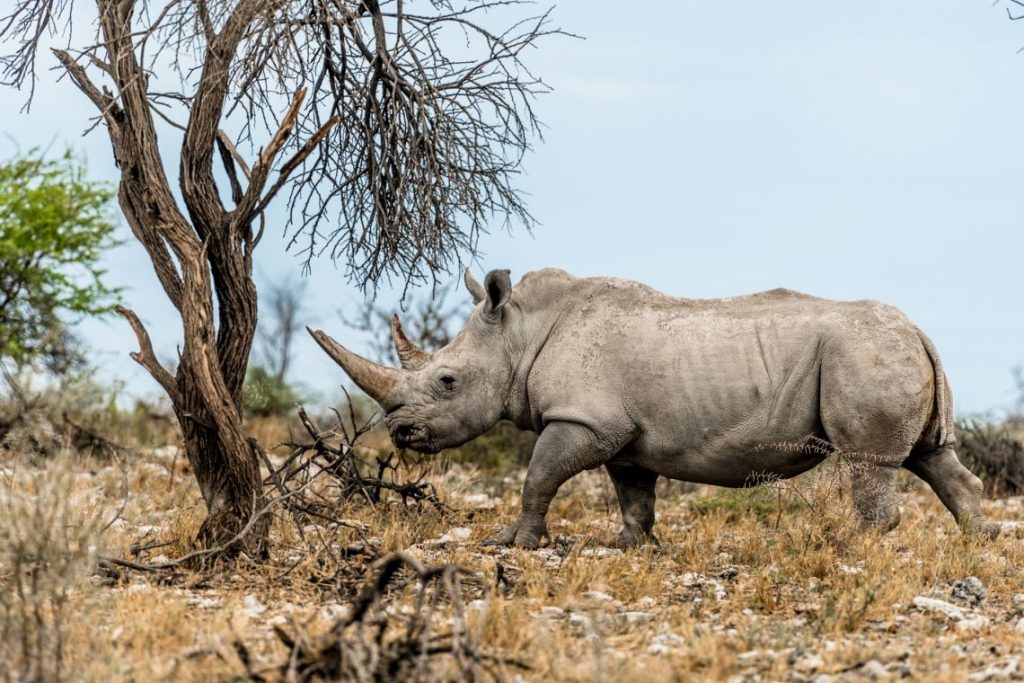
You can find Juan's work on his Instagram and Facebook.
"We Are f-stop" is for all f-stop users to share their stories from the field, from small daily adventures to epic travels. Contact us with your story on Facebook or drop us an email to [email protected] and let us know where your photography takes you and your f-stop pack!
SHOP ALL GEAR MORE WE ARE f-stop


©2022 F-stop
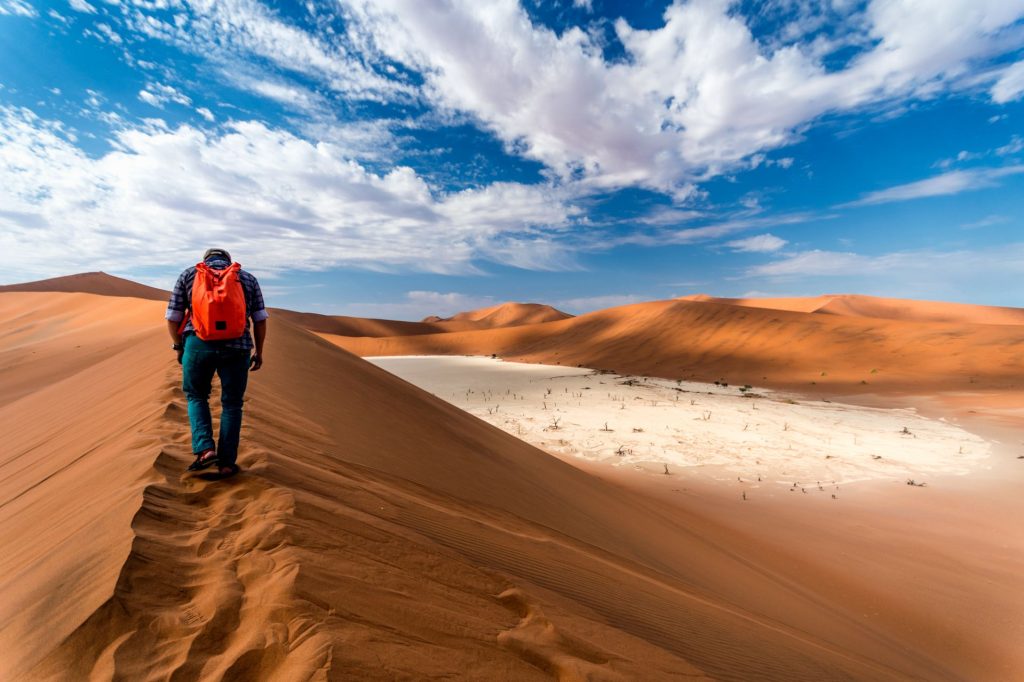
The adventure starts in the most extreme place in the world that is the Chilean Patagonia, which has the third natural reserve of fresh water of the planet. In the Campos de Hielo Sur (Southern Patagonian Ice Field) everything you see is an experience, its wild paths, fierce weather and unique landscapes. This journey is a milestone in my career as a photographer and as a person because being able to reach this place, it is necessary to be trained in extreme environments, practice your ice skills, glacier progression, rescue techniques, among others. After having said all of this, it is important to make a trip for several days to the most beautiful places of the planet as well as the most difficult ones. Every trip starts with a 3-hour flight to arrive to the only airport of the zone. Then, driving in a 4x4 car for a couple of days and don’t stop there but continuing by boat for another extra hours until we get to the landing point, where after three and a half days non-stop, eventually, we are at the beginning of this experience where kilometers and kilometers of ice is seen, always supported by local tour guides, who will be our safeguards, during this harsh journey.
Every trip to the Patagonia is challenging, but to go to the Southern Patagonian Ice Field is like getting into the wolf’s mouth because you won’t be sure if you are coming back. One of the biggest challenges was feeling exhausted physically and the extreme weather because you are responsible for carrying the total weight of your belongings, cameras, clothing, sleeping bag, food, etc. For that reason, I prepared myself in advance by training hard with overload as much as I could, also I prepared my technical equipment with my f-stop Shinn backpack with extra batteries, carbon fiber tripod, versatile lenses because it has an ideal size that resists efficiently against snow, rain, ice by keeping my photographic equipment in perfect conditions and everything necessary for an adventure like this, however, if you feel like the most prepared person, you realize that it is not enough or you forgot something, or something comes out suddenly or it is just the weather and the ice that reminds you don’t feel like home.
One night in the middle of the ice, a storm broke over us and the wind hit our dome house where we were staying, the cold felt all over our bodies because when it’s windy, the temperature goes down to 10°C, none of our sleeping bags kept us warm enough to tolerate the cold air and wind. The night felt endless in our bodies, we waited the wind calmed down its fury against us. The cold air along with the wind took the water from our skin, we dehydrated quickly and because of that our skin cracked while the night was endless for going to sleep. During this trip, I discovered new techniques to protect myself and develop my work efficiently. For example, I became minimalist about equipment and carrying weight so that you don’t overload your backpack or solving simple problems because if you don’t control them on time, they can become catastrophic like injured feet after walking a distance of 50 kilometers which is the same as having a wound exposed to air or any other movement like walking on millenary ice that can end up with a person falling into a crack that will never go out.
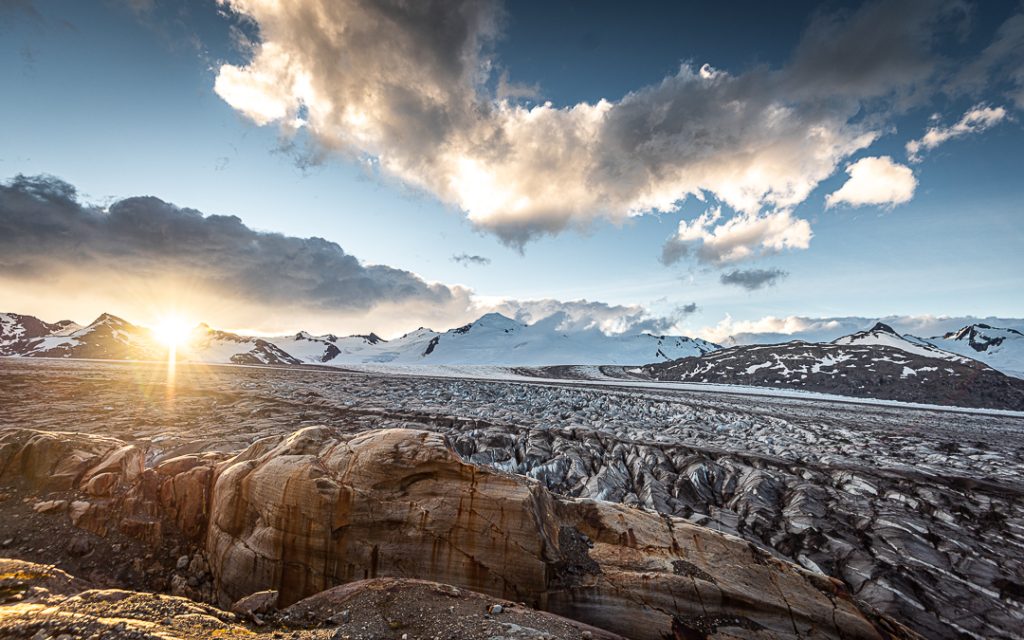
One of the best moments of this trip was being able to walk freely kilometers and kilometers of millenary ice, contemplate the purity of the landscape surroundings, drinking pure, crystal clear and clean water extracted from ice, feeling how a crack is opened under your feet, sleeping while you look up the starry sky without any light even the tiniest star of the firmament, having peace and time to take pictures of the scenery that very people has been allowed to glance and enjoy it, walking on the glaciers that will support life on the planet, however, it is worth noting that glaciers are retreating almost 1000 m per year, without any ice recovery, even so, it was mesmerizing to see kilometers and kilometers of ice that were surrounding us completely that became our base to walk, sleep and eat. We saw glacier cracks and walls in front of us that were just ice and nobody have never walked on before, we got filled with natural energy. In the Patagonian culture, food is very important, it means get together to drink mate, have a good conversation, eat fried pastries, roast meat and sharing stories. I was lucky to participate in this tradition, eating around a bonfire with wood from local forest, eating roasted meat from animals fed without any chemicals, freshly ground vegetables and eating fried pastries while they are hot.
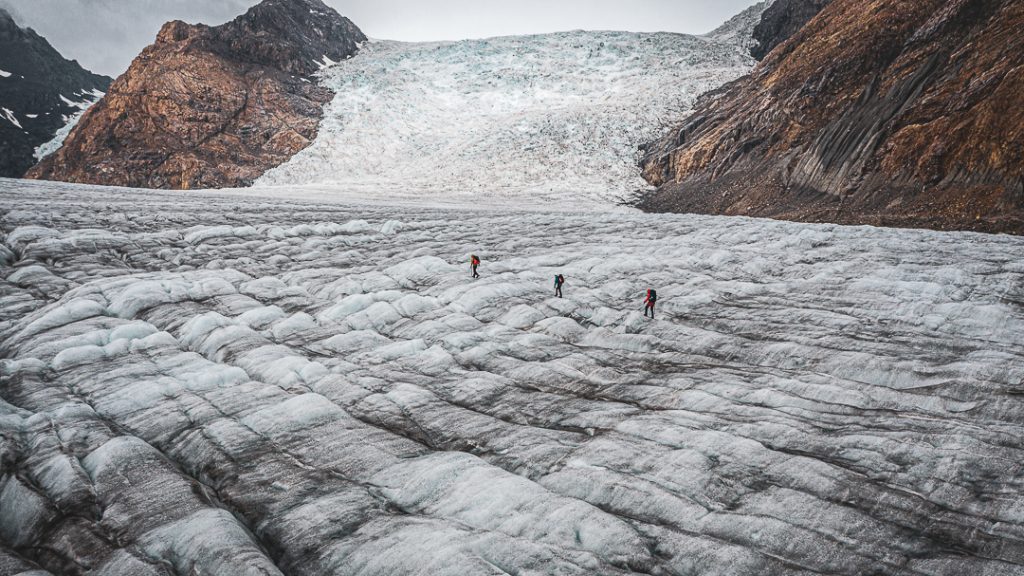
For this excursion, it is always advisable to have a full understanding of the potential environments to face, you need to be prepared physically, mentally and technically to survive in extreme environment conditions that might be there such as storms, cold air, lack of sleep or lack of food because if you are not prepared enough, you start loosing control of your mental and physical abilities which are the main cause of accidents and deaths in extreme places like Southern Patagonian Ice Field. One of the tricks I used was putting inside my backpack a double cover for the ICU where I had my camera equipment and above it putting all my clothes and my sleeping bag in order to avoid my batteries running down early. Another trick was carrying a duct tape that can fix everything and it is useful for emergencies to patch wounds, cuts and clothes when an accident occurs during the trip, besides sleeping as much as you can because the lack of sleep causes small errors that can end up in bad accidents.
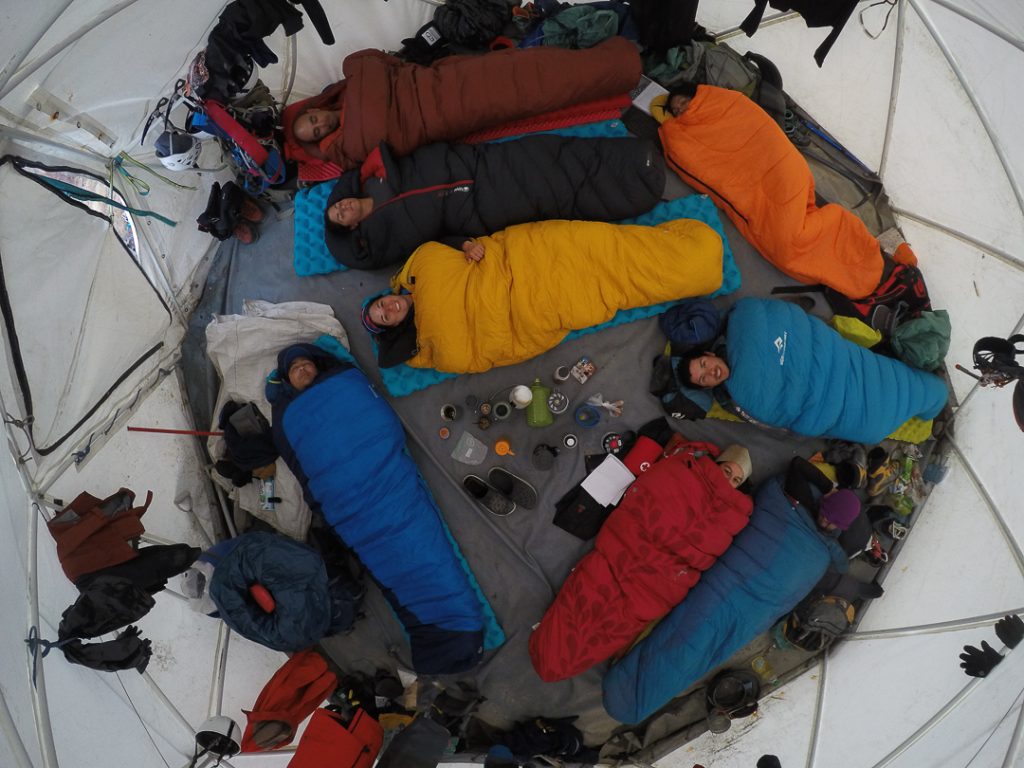
I am a photographer dedicated to live my life to the extreme in every adventure I go, experiencing it firsthand. I love telling the story from the inside as a narrator and adventurous person. If the adventure is at the the coldest place of the planet, I will be there doing what I love, generally you can find me in deserts, mountains, oceans, rivers or glaciers, everywhere someone is practicing a extreme sport, that’s where my home is, my photographic studio, my favorite place of the planet. Now, I hope traveling to the Sahara Desert to cross it again by rally driving for several weeks inside the endless dunar field and sand, but first, I will go to the glaciers of the Llaima Volcano in Chile to live a new adventure and see their unceasing cracks and stormy weather. You can check out my work and my excursions on my Instagram account @paolophotojournalist, currently I find myself visiting most of the Patagonia and looking for the best sportsmen and the most beautiful landscape to shoot.
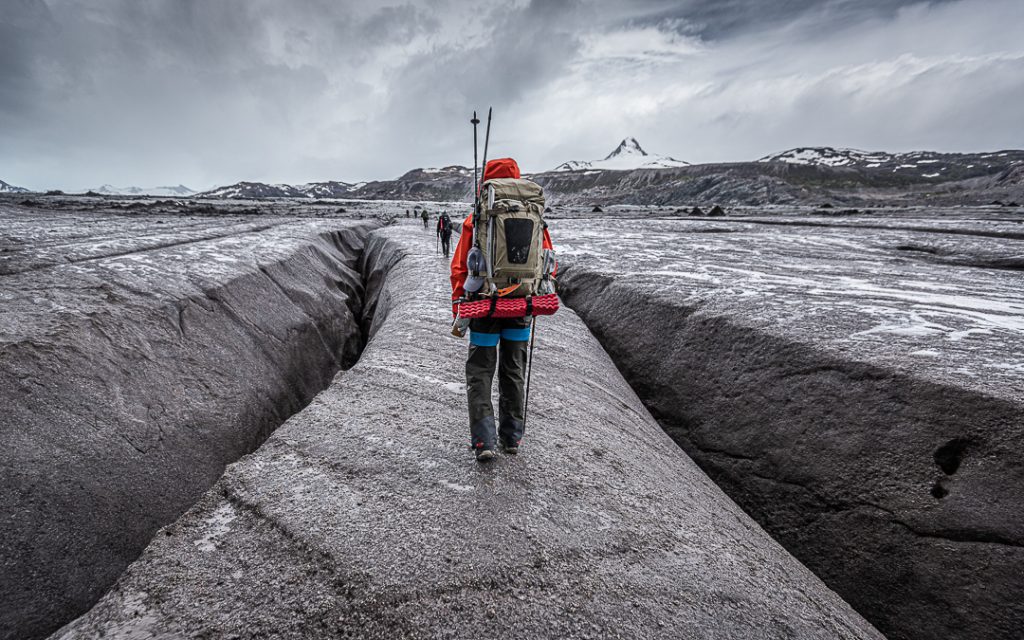
This trip took place in the Aysen Region, in the extreme south of Chile, specifically in the Southern Patagonian Ice Field, starting on January 05th, 2021 until January 25th, 2021. For this adventure, I travelled with my f-stop Shinn 80L backpack, one of the best mountain backpacks and having the Pro XL ICU, I reduced my photographic equipment with two cameras, three lenses and one drone. I chose this versatile and resistant backpack for its suitable capacity for the most severe environments, I needed to have enough space to carry my mountain clothing, rain clothes, food, sleeping bag, security equipment, climbing ropes, etc. Along with that, this backpack would be tied up, dragged over and transported without rest during this excursion. This backpack was created to give its utmost in the most intense environments, all this gear was a gift from Cuarto Digital, a photographic shop located in Chile that are responsible for bringing this brand to South America, which is very important because in Chile there are great extreme outdoor photographers and they need the best equipment for their adventures.
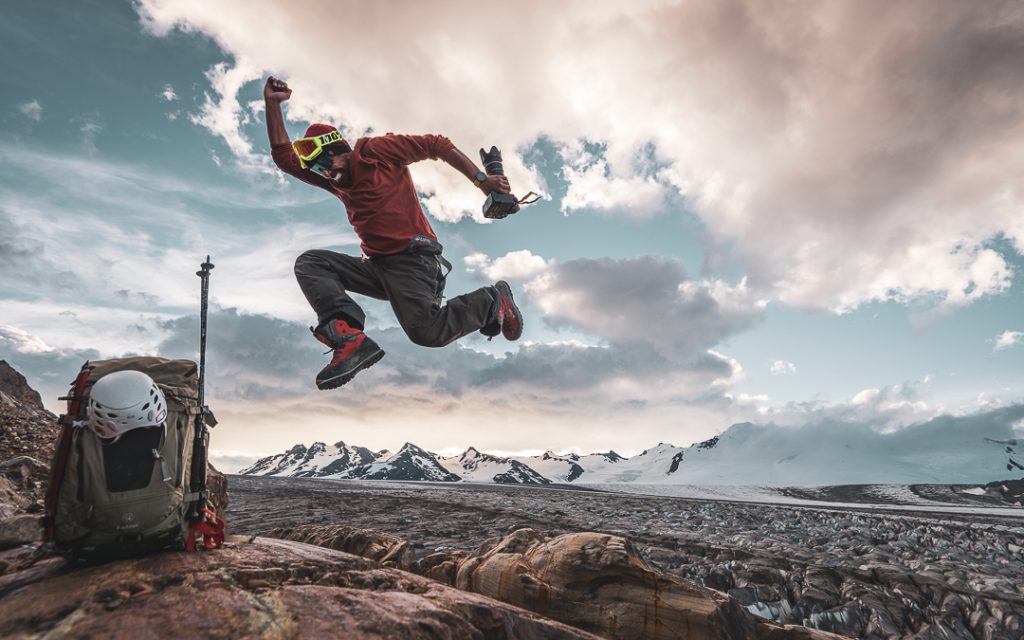
Paolo Avila is a person who loves simple things, born in Chile, country of natural contrasts, high-performance athlete, he is specialized in photography, extreme sports and also a survival expert. Nowadays, his life is divided by two suitcases, one for his clothes and the other one for his cameras. His backyard is the airport and his home is where no one can go, inhospitable deserts, giant glaciers, enormous mountains and rough rivers. He is passionate about living to the limit and capture the moment, experiencing adventures and taking photos firsthand. He loves feeling the adrenaline running through his body while he is descending waterfalls or covering up in the snow to survive. Having this lifestyle, Paolo is sponsored by different brands such as Lippi, Nikon, Cuarto Digital and Stanley that motivate him to keep living to the limit and he has been called to be part of the greatest teams created by Restart, which have worked in the most difficult events of the planet.

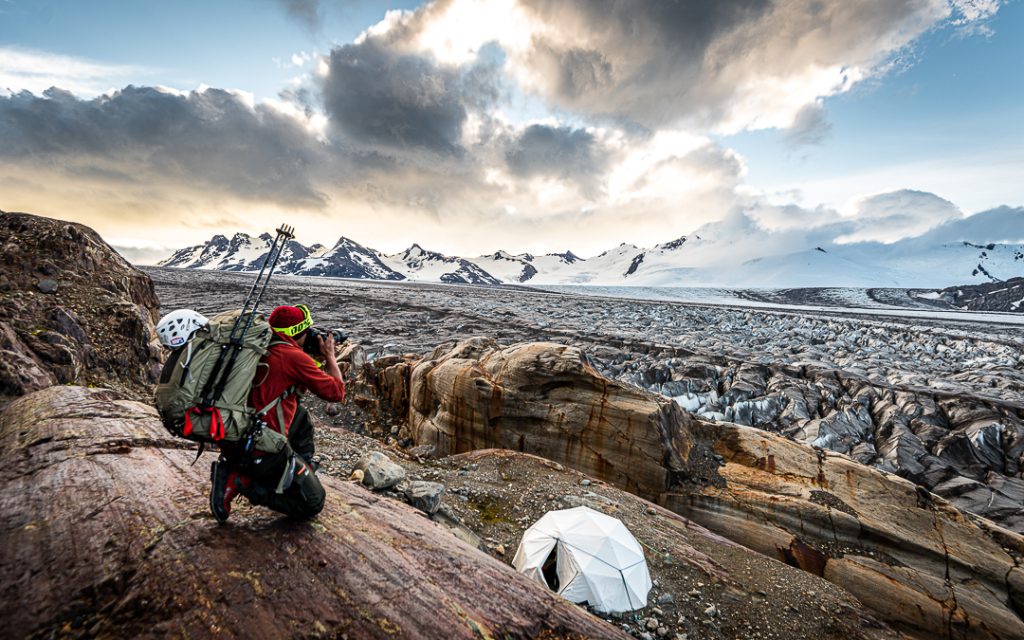
The adventure starts in the most extreme place in the world that is the Chilean Patagonia, which has the third natural reserve of fresh water of the planet. In the Campos de Hielo Sur (Southern Patagonian Ice Field) everything you see is an experience, its wild paths, fierce weather and unique landscapes. This journey is a milestone in my career as a photographer and as a person because being able to reach this place, it is necessary to be trained in extreme environments, practice your ice skills, glacier progression, rescue techniques, among others. After having said all of this, it is important to make a trip for several days to the most beautiful places of the planet as well as the most difficult ones. Every trip starts with a 3-hour flight to arrive to the only airport of the zone. Then, driving in a 4x4 car for a couple of days and don’t stop there but continuing by boat for another extra hours until we get to the landing point, where after three and a half days non-stop, eventually, we are at the beginning of this experience where kilometers and kilometers of ice is seen, always supported by local tour guides, who will be our safeguards, during this harsh journey.
Every trip to the Patagonia is challenging, but to go to the Southern Patagonian Ice Field is like getting into the wolf’s mouth because you won’t be sure if you are coming back. One of the biggest challenges was feeling exhausted physically and the extreme weather because you are responsible for carrying the total weight of your belongings, cameras, clothing, sleeping bag, food, etc. For that reason, I prepared myself in advance by training hard with overload as much as I could, also I prepared my technical equipment with my f-stop Shinn backpack with extra batteries, carbon fiber tripod, versatile lenses because it has an ideal size that resists efficiently against snow, rain, ice by keeping my photographic equipment in perfect conditions and everything necessary for an adventure like this, however, if you feel like the most prepared person, you realize that it is not enough or you forgot something, or something comes out suddenly or it is just the weather and the ice that reminds you don’t feel like home.
One night in the middle of the ice, a storm broke over us and the wind hit our dome house where we were staying, the cold felt all over our bodies because when it’s windy, the temperature goes down to 10°C, none of our sleeping bags kept us warm enough to tolerate the cold air and wind. The night felt endless in our bodies, we waited the wind calmed down its fury against us. The cold air along with the wind took the water from our skin, we dehydrated quickly and because of that our skin cracked while the night was endless for going to sleep. During this trip, I discovered new techniques to protect myself and develop my work efficiently. For example, I became minimalist about equipment and carrying weight so that you don’t overload your backpack or solving simple problems because if you don’t control them on time, they can become catastrophic like injured feet after walking a distance of 50 kilometers which is the same as having a wound exposed to air or any other movement like walking on millenary ice that can end up with a person falling into a crack that will never go out.

One of the best moments of this trip was being able to walk freely kilometers and kilometers of millenary ice, contemplate the purity of the landscape surroundings, drinking pure, crystal clear and clean water extracted from ice, feeling how a crack is opened under your feet, sleeping while you look up the starry sky without any light even the tiniest star of the firmament, having peace and time to take pictures of the scenery that very people has been allowed to glance and enjoy it, walking on the glaciers that will support life on the planet, however, it is worth noting that glaciers are retreating almost 1000 m per year, without any ice recovery, even so, it was mesmerizing to see kilometers and kilometers of ice that were surrounding us completely that became our base to walk, sleep and eat. We saw glacier cracks and walls in front of us that were just ice and nobody have never walked on before, we got filled with natural energy. In the Patagonian culture, food is very important, it means get together to drink mate, have a good conversation, eat fried pastries, roast meat and sharing stories. I was lucky to participate in this tradition, eating around a bonfire with wood from local forest, eating roasted meat from animals fed without any chemicals, freshly ground vegetables and eating fried pastries while they are hot.

For this excursion, it is always advisable to have a full understanding of the potential environments to face, you need to be prepared physically, mentally and technically to survive in extreme environment conditions that might be there such as storms, cold air, lack of sleep or lack of food because if you are not prepared enough, you start loosing control of your mental and physical abilities which are the main cause of accidents and deaths in extreme places like Southern Patagonian Ice Field. One of the tricks I used was putting inside my backpack a double cover for the ICU where I had my camera equipment and above it putting all my clothes and my sleeping bag in order to avoid my batteries running down early. Another trick was carrying a duct tape that can fix everything and it is useful for emergencies to patch wounds, cuts and clothes when an accident occurs during the trip, besides sleeping as much as you can because the lack of sleep causes small errors that can end up in bad accidents.

I am a photographer dedicated to live my life to the extreme in every adventure I go, experiencing it firsthand. I love telling the story from the inside as a narrator and adventurous person. If the adventure is at the the coldest place of the planet, I will be there doing what I love, generally you can find me in deserts, mountains, oceans, rivers or glaciers, everywhere someone is practicing a extreme sport, that’s where my home is, my photographic studio, my favorite place of the planet. Now, I hope traveling to the Sahara Desert to cross it again by rally driving for several weeks inside the endless dunar field and sand, but first, I will go to the glaciers of the Llaima Volcano in Chile to live a new adventure and see their unceasing cracks and stormy weather. You can check out my work and my excursions on my Instagram account @paolophotojournalist, currently I find myself visiting most of the Patagonia and looking for the best sportsmen and the most beautiful landscape to shoot.

This trip took place in the Aysen Region, in the extreme south of Chile, specifically in the Southern Patagonian Ice Field, starting on January 05th, 2021 until January 25th, 2021. For this adventure, I travelled with my f-stop Shinn 80L backpack, one of the best mountain backpacks and having the Pro XL ICU, I reduced my photographic equipment with two cameras, three lenses and one drone. I chose this versatile and resistant backpack for its suitable capacity for the most severe environments, I needed to have enough space to carry my mountain clothing, rain clothes, food, sleeping bag, security equipment, climbing ropes, etc. Along with that, this backpack would be tied up, dragged over and transported without rest during this excursion. This backpack was created to give its utmost in the most intense environments, all this gear was a gift from Cuarto Digital, a photographic shop located in Chile that are responsible for bringing this brand to South America, which is very important because in Chile there are great extreme outdoor photographers and they need the best equipment for their adventures.

Paolo Avila is a person who loves simple things, born in Chile, country of natural contrasts, high-performance athlete, he is specialized in photography, extreme sports and also a survival expert. Nowadays, his life is divided by two suitcases, one for his clothes and the other one for his cameras. His backyard is the airport and his home is where no one can go, inhospitable deserts, giant glaciers, enormous mountains and rough rivers. He is passionate about living to the limit and capture the moment, experiencing adventures and taking photos firsthand. He loves feeling the adrenaline running through his body while he is descending waterfalls or covering up in the snow to survive. Having this lifestyle, Paolo is sponsored by different brands such as Lippi, Nikon, Cuarto Digital and Stanley that motivate him to keep living to the limit and he has been called to be part of the greatest teams created by Restart, which have worked in the most difficult events of the planet.



Discount Applied Successfully!
Your savings have been added to the cart.